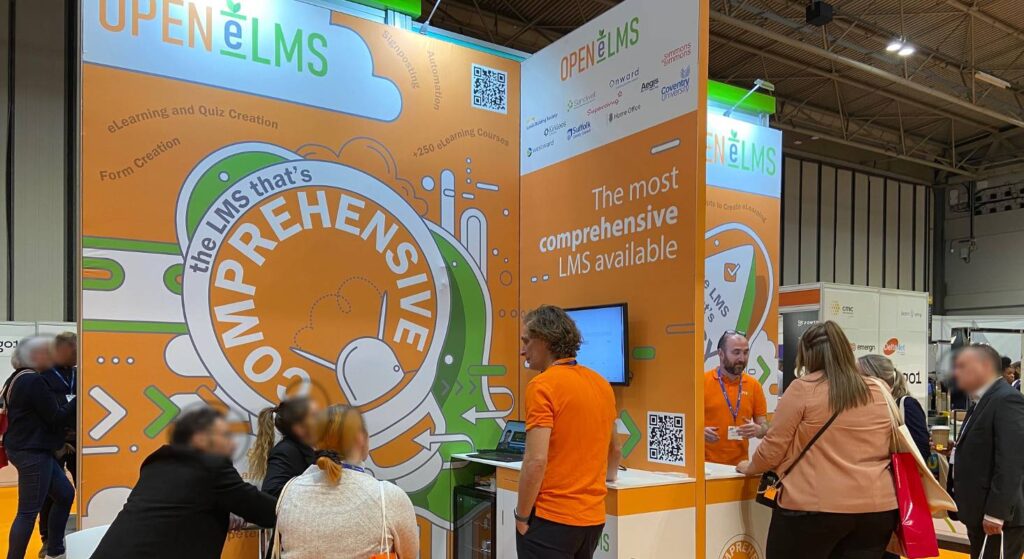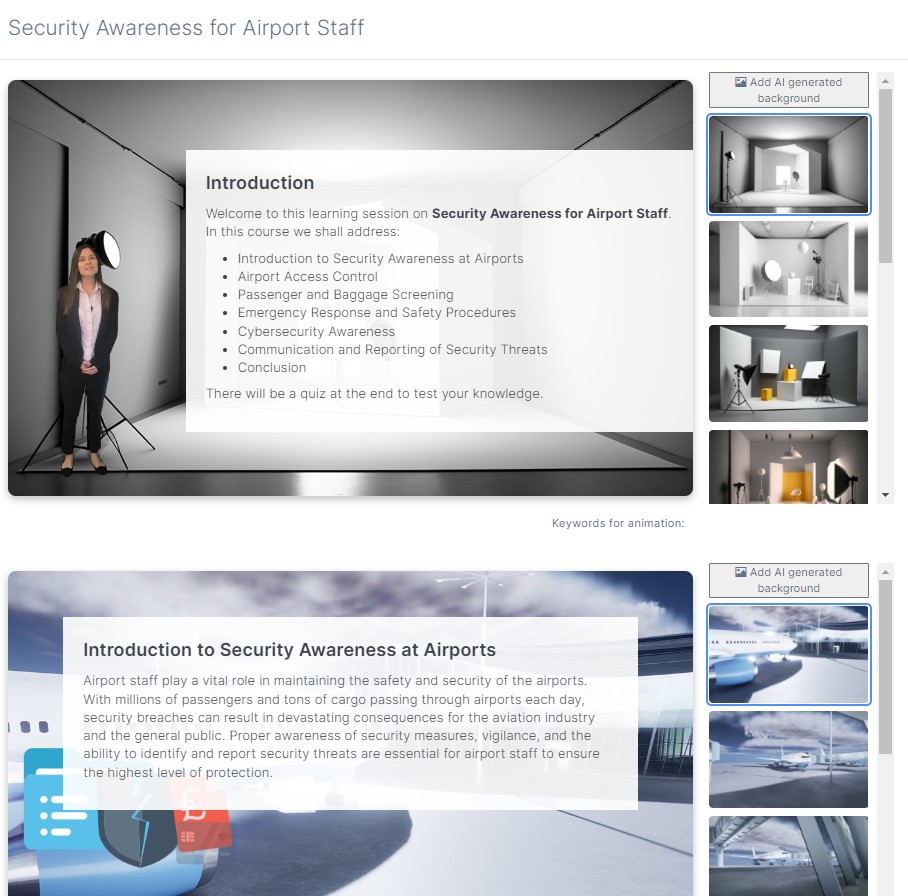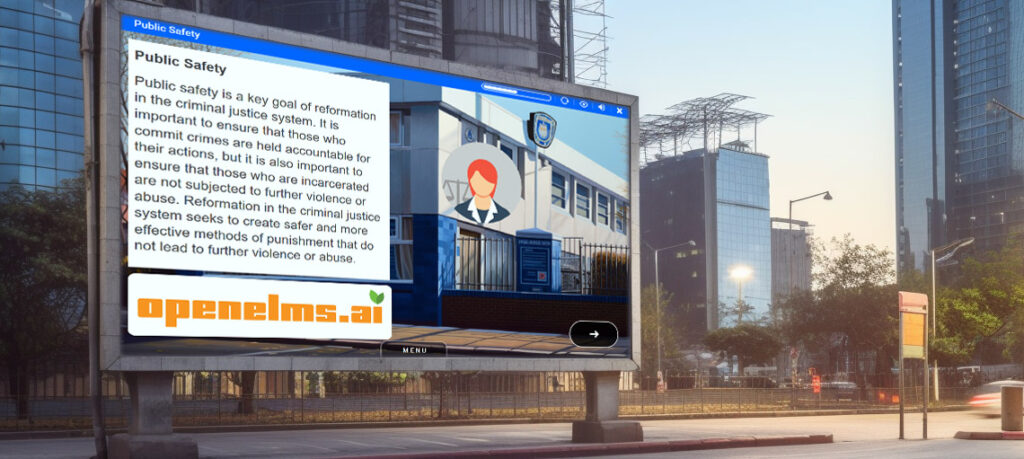Open eLMS Chat – Custom Chat GTP

At Open eLMS we are excited to announce the launch of Open eLMS Chat – our brand new chat engine! With this new feature, you can create a completely customizable AI chatbot that fits your company’s unique data and needs. One of the best things about Open eLMS Chat is how easy it is to use. With the admin interface, you don’t need any coding skills to personalize your chatbot. Simply follow the prompts and customize to your heart’s content! The possibilities with Open eLMS Chat are endless. You can use it to answer customer questions, provide tech support, and even generate leads. Plus, with the ability to integrate with other Open eLMS features, the sky’s the limit! So what are you waiting for? Give Open eLMS Chat a try and see how it can benefit your business. We can’t wait to see what you create with it!
Learning Technologies 2023

Launches openelms.ai openelms.ai – the AI powered eLearning Creator – was launched at the Learning Technologies Show 2023, 3rd to 4th May . Openelms.ai is the brainchild of Managing Director Emil Reisser-Weston, who saw a need for a faster, more efficient way to create eLearning courses. He’s been working tirelessly to develop our AI-powered platform, which allows users to create eLearning courses in under 60 seconds – no joke! That’s right, with Openelms.ai, you can create eLearning courses faster than ever before. Our platform uses natural language processing and machine learning algorithms to analyse your content and create courses that are tailored to your specific needs. And because everything is automated, there’s no need for a subject matter expert, designer, or project manager – it’s all done by our AI. But don’t just take our word for it – see what some stand visitors had to say. Sign up to the free version of openelms.ai and start building your own ai generated elearning today.
How to Use AI in eLearning Development in 2023

Personalised Learning: The Impact of AI on the eLearning Industry Artificial intelligence is revolutionising the eLearning industry by providing personalised learning experiences, automating administrative tasks, and enabling better assessment and feedback mechanisms. AI is also making it easier to offer private video hosting, ensuring secure and controlled access to sensitive training content, which is particularly important for corporate and compliance-based learning. We are using the power of AI to make eLearning more efficient, effective, and engaging for learners around the world. We have been making eLearning over the last 20 years, but have found that recently the demand for eLearning has accelerated rapidly. We are creating eLearning for organisations at a faster pace to keep up with demand. We have found that many organisations are now using rapid authoring tools, agile methodologies, and automated processes to speed up the eLearning courseware creation process. This improves productivity but the end results can be questionable. I always say ‘Simply giving someone a paintbrush does not make them an artist.’ At Open eLMS we leverage technologies such as machine learning and adaptive learning. We can use our AI driven eLearning platforms to automatically create personalised content recommendations, assessments, and feedback. This leads to better learning outcomes and higher learner engagement. No longer do we need to design a one size fits all approach to learning. We can use AI to create personalised learning paths and even personalised learning content – down to the individual eLearning course. Key AI Technologies that will transform eLearning: From machine learning to Natural Language Processing Machine learning and deep learning have a significant impact on eLearning by enabling intelligent content creation, automated assessment, and adaptive learning experiences. We have been leveraging these technologies within our own learning platforms. Our technology can analyse learners’ data and behaviour to provide a personalised learning experience. We use Artificial Intelligence to change the learning process from one where the learner will have personalised learning modules suggested and even created for them, rather than searching through a library of course material. We use AI to create eLearning material quickly and easily. Check out our article on Using AI to write eLearning scripts and AI generated scripts. I am sure that very soon it will be standard to create eLearning using AI in the same way we would do a Google Search. eLearning will be automatically created within LMSs by ai systems to satisfy prescribed needs rather than be assigned by Learning Management System (LMS) administrators. LMS creates eLearning using AI Natural language processing (NLP) is a branch of Artificial Intelligence that enables machines to understand, interpret, and generate human language. At Open eLMS we have created company specific conversational interfaces, chatbots, and voice-enabled assistants to communicate directly with learners on organisation specific topics. Such chat systems will very soon be embedded within Learning Management Systems – such as Open eLMS as standard. We believe that sign-posting, rather than rote learning, will enable learners to manage complex tasks at their own pace, with just-in-time information. Corporate training and online education need not be a classroom type experience or webinar. We have created an organisational brain (or NLP virtual assistant) to offer personalised support as and when needed. Virtual reality and augmented reality technologies have the potential to revolutionise e learning by providing immersive and interactive learning experiences. By simulating real-world scenarios and environments, these technologies can improve learners’ retention, engagement, and performance in a variety of fields, from healthcare and engineering to sales and marketing. I predict that with AI entering eLearning course creation, personalized learning experiences will become increasingly sophisticated. As a result, we have found that AI content creation allows us to move away from traditional training paradigms, we can now create virtual learning worlds (rather than 2D presentations), since sophisticated eLearning is now so much easier to produce. We have compiled a summary of technologies available to create eLearning is available here else view the video on YouTube: How we are using AI to Create eLearning. Openelms.ai: AI-Driven Content Creation is here! We all know that the development of course materials can be a time-consuming and resource-intensive process. As alluded to earlier in this article, we have created an Artificial Intelligence driven eLearning authoring tool called ‘openelms.ai’. This will allow our clients to streamline the entire course development process and dramatically reduce costs. We can use openelms.ai to produce interactive eLearning courses with video presenters in virtual learning worlds. The elearning will match the student’s learning style and can be ready in under a minute from conception to delivery. We estimate that this is at 1/2,700 of the previous development life cycle, all for less than the cost of a cup of coffee! Our clients can enter a single line of text, openelms.ai then uses machine learning algorithms to determine the personalising learning objectives, quiz and script remaining eLearning content accordingly. This Artificial Intelligence AI powered design tool, then designs the screen, creating and curating learning material (images, animation and video) with human trainer guides who act as virtual assistants. We have found that interactive learning experiences are critical to engaging learners and promoting a deeper learning pedagogy. openelms.ai can leverage interactive elements such as quizzes, knowledge checks and branching scenarios to create immersive and engaging learning experiences. When designing openelms.ai, we ensured that the learning content and language can be personalised to the learner’s skill level and language. Thanks to machine learning, creating assessments and educational content online has never been easier. Bespoke online courses are no longer limited to corporate training, as the education industry can also benefit from the use of Artificial Intelligence. Our aim though has never been to replicate existing course material, instead we want to better it. We have made a video of how the system works so you can judge for yourself: openelms.ai – Create eLearning in 60 seconds else it can be accessed for free directly at openelms.ai. Benefits of using Artificial Intelligence: What are they? Efficient creation of eLearning courses: We use AI
AI-Powered LMS: Your Key to Personalised and Efficient E-Learning

AI-Powered LMS: The Next Generation of E-Learning The Future of E-Learning: AI-Powered Learning Management Systems How we use AI in our Learning Management Systems At Open eLMS we are creating an AI based LMS which uses machine learning algorithms and natural language processing to analyse data on students performance and provide personalised recommendations to students. This can include personalised learning paths, feedback on student performance, and suggestions for additional resources that can help students. We have found that the AI-powered LMS can also help instructors by automating administrative tasks. Repetitive tasks such as grading assignments and providing feedback to students have always been a feature of LMSs, but now we can go further. We are also using AI to produce more personalised and effective online learning for students which matches each learner’s knowledge level. In testing we have found that this greatly reduces the workload and training hours for instructors and improves the overall efficiency of the learning process. The AI technologies include: Machine learning: This technology can be used to analyse data and make predictions about student performance, identify knowledge gaps, and personalise the learning material for each student. Natural language processing: This technology uses deep learning algorithms to provide feedback on grammar, spelling, and syntax. Chatbots: These conversational agents can be used to answer student questions in real-time, provide guidance on assignments and assessments, and offer personalised feedback. Computer vision: This technology can be used to analyse student engagement and behaviour during video lectures, and provide feedback on attention levels, participation, and comprehension. Recommender systems: These systems can be used to recommend additional learning materials based on their interests and learning preferences. How AI affects the ROI We have found that Artificial Intelligence is like having an army of interns working for you for free, significantly improving the quality and capabilities of key elements of your Learning Management System. This leads to efficiencies which dramatically increase our customers ROI. This includes: Personalised learning paths: An AI-powered LMS can create personalised learning paths for each student based on their learning objectives, skills, and knowledge gaps. This can help students focus on the specific areas they need to improve, reducing the amount of time spent on irrelevant or redundant material. Automated grading and feedback: AI-powered tools can automate grading and provide feedback to students, reducing the time and effort required from instructors. This allows instructors to focus on providing more personalised feedback and addressing individual student needs. Predictive analytics: an AI LMS can use Artificial Intelligence to analyse student data to predict which areas they may struggle with, allowing instructors to proactively address these areas and reduce the amount of time spent on remediation. Intelligent content curation: An AI-powered LMS can curate content intelligently, suggesting relevant resources and online learning materials that students need to complete their course. This can help students save time in searching for appropriate resources. Automated administrative tasks: The AI LMS can automate administrative tasks such as scheduling, registration, and payment, reducing the time spent on manual administrative tasks. 20 years of experience has shown us that well trained employees are not only more productive, but also more engaged! No more will the company’s learning platform be merely a record of training data, Artificial Intelligence will lead the Learning Management System to have both significant direct and indirect benefits for each organisation. Successful Through the AI-Powered LMS Our experience has shown us that an AI-powered LMS will streamline corporate training and employee development programs by providing personalised learning experiences that are tailored to each employee’s individual learning style, pace, and skill level. Your learning platform will then deliver more efficient and effective training outcomes. This personalized learning experience will lead to employees receiving more targeted learning quicker than before. LMS generates eLearning using AI We are designing Open eLMS – our AI-powered LMS – so that it can also help companies track and measure the impact of their training programs through data analytics. This will allow users of the learning platform to identify areas of improvement and adjust their training strategies accordingly. This can help companies improve employee retention, productivity, and job satisfaction, leading to a more successful and competitive business. AI-powered LMS will soon configure themselves to deliver more relevant content and courses for different roles. The learning will reflect the latest thinking, so companies can ensure that their employees are up-to-date with the latest industry trends, technologies, and best practices. This can help companies stay competitive and agile in a rapidly changing business landscape, and position themselves as leaders in their respective industries. We always say that the best business decisions are driven by data. Companies that leverage data are more likely to achieve success than those that rely solely on intuition or experience. An AI-powered LMS can provide data analytics and insights about their training and development programs; this in turn will lead to improved employee performance, productivity, and job satisfaction. Squeezing AI into an Existing Learning Management System When integrating Artificial Intelligence into an existing LMS, there are several benefits for the entire learning process: Personalised learning experiences: An AI algorithm can analyse user data such as their learning preferences, past performance, and knowledge gaps to provide personalised learning experiences. No two learners should have the same learning outcome. Improved learner engagement: AI-powered LMS can offer interactive and engaging learning experiences that can improve learner engagement and retention of material. For example, AI-powered chatbots can provide personalised feedback and support to learners, enhancing the learning experience. Automated grading and assessment: AI algorithms can automate grading and assessment, freeing up instructors’ time to focus on providing personalised feedback and support to learners. Data-driven decision making: AI algorithms can analyse large amounts of data generated by the LMS to provide insights into learner performance, training effectiveness, and areas for improvement. This can help instructors and administrators make data-driven decisions about training strategies and program improvements. Reduced costs: AI-powered LMS can reduce the costs associated with traditional classroom-based training by offering flexible and scalable learning
openelms.ai – the first elearning designed 100% using AI

Introduction Since the recent renaissance of AI the clock has been ticking to produce a product that creates real eLearning from a text prompt. The technology exists for producing research scripts on any topic, images and video based on that text and AI can now read an image which allow it to select the right animation for each image and place elements in accordance with good design heuristics. openelms.ai – years in the making Open eLMS recognised the potential early and has been developing openelms.ai for a few years. Furthermore the design system is built on it’s online eLearning authoring tool – Open eLMS Creator – which has been pushing the boundaries of what is possible in eLearning design for the last 15 years. This means any AI generated course can be edited after delivery, using a simple drag and drop style interface. How does it work? openelms.ai requires no prior instruction, simply enter your eLearning requirement, select the length of the course (number of slides) and whether you want a quiz at the end. openelms.ai will then get to work and generate the course for you, this will include video presenters, images, animation and background scenes in which you are setting your learning. The system will also design several options for each screen so you can select the most appropriate or, if none of the designs are suitable, you can generate your own using Chat GPT’s own image generator. If any of this sounds complex, don’t worry it’s not. The process should take less than 60 second from start to finish. What does the eLearning look like? The eLearning is an immersive and engaging experience, basing the learning in virtual learning worlds. This is not a presentation or vertical scrolling experience, the learning is closer in feel to an interactive documentary. In an independent study carried out by the UK’s largest provider of social housing, this eLearning was found to have approval rates of 99%. Furthermore the eLearning has all the features you would expect in any eLearning such as interactive quizzes and knowledge checks. And this is only the start, openelms.ai will be introducing customised computer generated presenters so you can star in your own eLearning and video production elements as the AI technology evolves. How can I access openelms.ai for free? openelms.ai are offering a free version of this system at the launch. Simply go to www.openelms.ai and register to generate your eLearning. The eLearning course can then be downloaded and ran within any Learning Management System. We implore you to give it a go, it will take 60 seconds to change your approach to eLearning creation for life. Access Details www.openelms.ai Further Information openelms.ai – the first eLearning designed 100% using AIopenelms.ai – an early view!Learning News: 5 Artificial Intelligence tools you need to start using now to build eLearning
openelms.ai – the first elearning designed 100% using AI

openelms.ai has recently created the world’s first eLearning courses designed entirely using AI from a single line of text. These short courses took a matter of seconds to produce from a single line of text. The eLearning is available for preview on their website, and they provide a glimpse of the capabilities of the OpenElms.ai platform. The eLearning consists of 7 screens and are for demonstration purposes, the finished system will allow creators to produce courses of any length. The AI-designed courses are comprehensive, easy to navigate, and engaging. The courses utilize a range of multimedia, such as videos, infographics, and interactive quizzes, to enhance the learning experience. The system is due for release at the end of April 2023.
openelms.ai – an early view!
https://youtu.be/e1_s699cBE0 openelms.ai is an eLearning creation system which delivers learning courses of breathtaking quality from a single line of text. This Adobe Captive / Articulate killer is a read game-changer for education and corporate training. The system is due for release at the end of April 2023.
How we are using AI to Create eLearning
Artificial Intelligence can create elearning in seconds – we will show you how This video demonstrates the unique systems and services used by Open eLMS to produce truly engaging e-learning. See www.openelms.ai for further details. Other links of relevance include: MidJourney – excellent image maker Dalle-2 – Open AI’s alternative Chat GPT – need we say any more? D-id – talking heads for eLearning descript – voiceover using text in your own voice openelms.ai – eLearning with a single line of text
Is AI the great EdTech disrupter?
In this video, Emil Reisser-Weston – Open eLMS Product Director – discusses how AI will shape the EdTech industry with references to openelms.ai.
The advantages of AI for elearning creation

Introduction Artificial Intelligence (AI) has been rapidly transforming various industries, and eLearning is no exception. With AI-powered tools, elearning content creation has become faster, easier, and more personalized than ever before. In this article, we will explore the benefits of AI in eLearning content creation and how it can improve the learning experience for students. Personalized Learning One of the most significant benefits of AI in eLearning content creation is personalized learning. With AI-powered tools, educators can create personalized content based on a student’s learning style, preferences, and performance data. This allows students to learn at their own pace and level, improving their engagement and overall learning outcomes. Personalized learning also helps educators identify knowledge gaps and provide targeted interventions to improve student understanding. Increased Efficiency AI-powered eLearning content creation is more efficient than traditional methods. It can create content quickly, accurately, and consistently, allowing educators to focus on other aspects of their job, such as teaching and engaging with students. This efficiency saves time and reduces costs, making eLearning more accessible to a broader audience. Elearning can be created in seconds using openelms.ai Enhanced Engagement AI-powered eLearning content creation can significantly enhance student engagement. With interactive content, such as videos and simulations, students are more likely to retain information and engage with the material. AI-powered content can also adapt to a student’s performance, providing feedback and adjusting the difficulty level of the content accordingly. This personalized approach can improve student motivation and interest in learning. Improved Accessibility AI-powered eLearning content creation can improve accessibility for students with disabilities. For example, text-to-speech technology can convert written content into audio format, making it accessible to students with visual impairments. This technology can also benefit students with dyslexia or other learning disabilities, providing them with alternative ways to learn and engage with the material. All openelms.ai courses include voiceovers and video presenters in up to 27 different languages Consistent Quality AI-powered eLearning content creation provides consistent quality across all content, regardless of the amount produced. The use of AI-powered tools ensures that content is created in a standardized format and is free of human error, ensuring high quality and accuracy. This consistency is essential in eLearning, where learners expect high-quality content that is easy to understand and learn from. AI elearning creation tool – openelms.ai – produces elearning of consistent quality Cost Savings AI-powered eLearning content creation can be cost-effective for educational institutions. The use of AI-powered tools reduces the need for human labor, saving time and costs associated with traditional content creation methods. Additionally, AI can generate content at a faster pace than humans, enabling educators to create more content in less time. Conclusion AI-powered eLearning content creation has numerous benefits, including personalized learning, increased efficiency, enhanced engagement, improved accessibility, consistent quality, and cost savings. With AI-powered tools, educators can create engaging and effective eLearning content that meets the needs of individual learners, providing an optimal learning experience. As AI technology continues to evolve, we can expect to see even more innovative solutions for eLearning content creation.
